2005 AUDI A6 engine
[x] Cancel search: enginePage 25 of 92
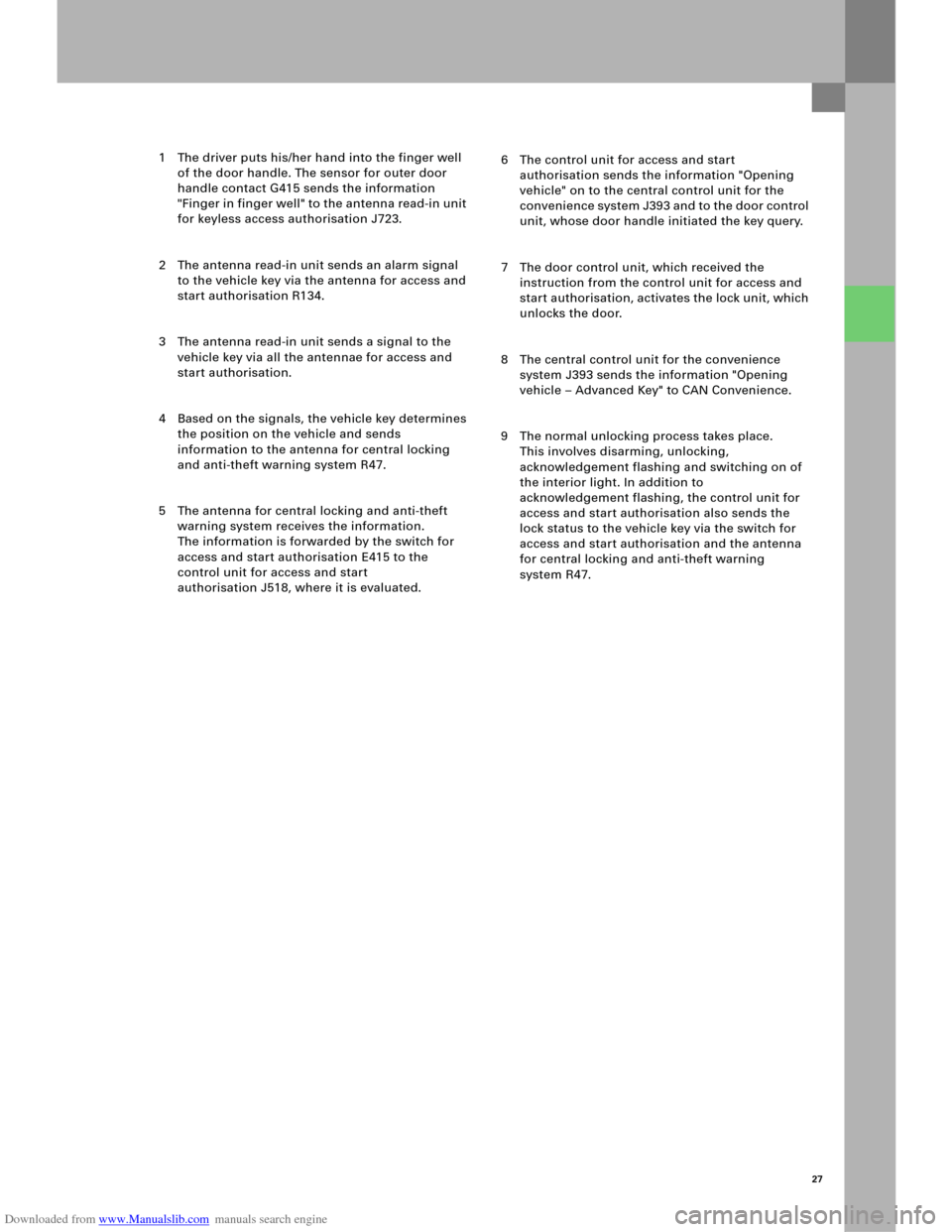
Downloaded from www.Manualslib.com manuals search engine 27
1 The driver puts his/her hand into the finger well
of the door handle. The sensor for outer door
handle contact G415 sends the information
"Finger in finger well" to the antenna read-in unit
for keyless access authorisation J723.
2 The antenna read-in unit sends an alarm signal
to the vehicle key via the antenna for access and
start authorisation R134.
3 The antenna read-in unit sends a signal to the
vehicle key via all the antennae for access and
start authorisation.
4 Based on the signals, the vehicle key determines
the position on the vehicle and sends
information to the antenna for central locking
and anti-theft warning system R47.
5 The antenna for central locking and anti-theft
warning system receives the information.
The information is forwarded by the switch for
access and start authorisation E415 to the
control unit for access and start
authorisation J518, where it is evaluated.6 The control unit for access and start
authorisation sends the information "Opening
vehicle" on to the central control unit for the
convenience system J393 and to the door control
unit, whose door handle initiated the key query.
7 The door control unit, which received the
instruction from the control unit for access and
start authorisation, activates the lock unit, which
unlocks the door.
8 The central control unit for the convenience
system J393 sends the information "Opening
vehicle – Advanced Key" to CAN Convenience.
9 The normal unlocking process takes place.
This involves disarming, unlocking,
acknowledgement flashing and switching on of
the interior light. In addition to
acknowledgement flashing, the control unit for
access and start authorisation also sends the
lock status to the vehicle key via the switch for
access and start authorisation and the antenna
for central locking and anti-theft warning
system R47.
Page 26 of 92
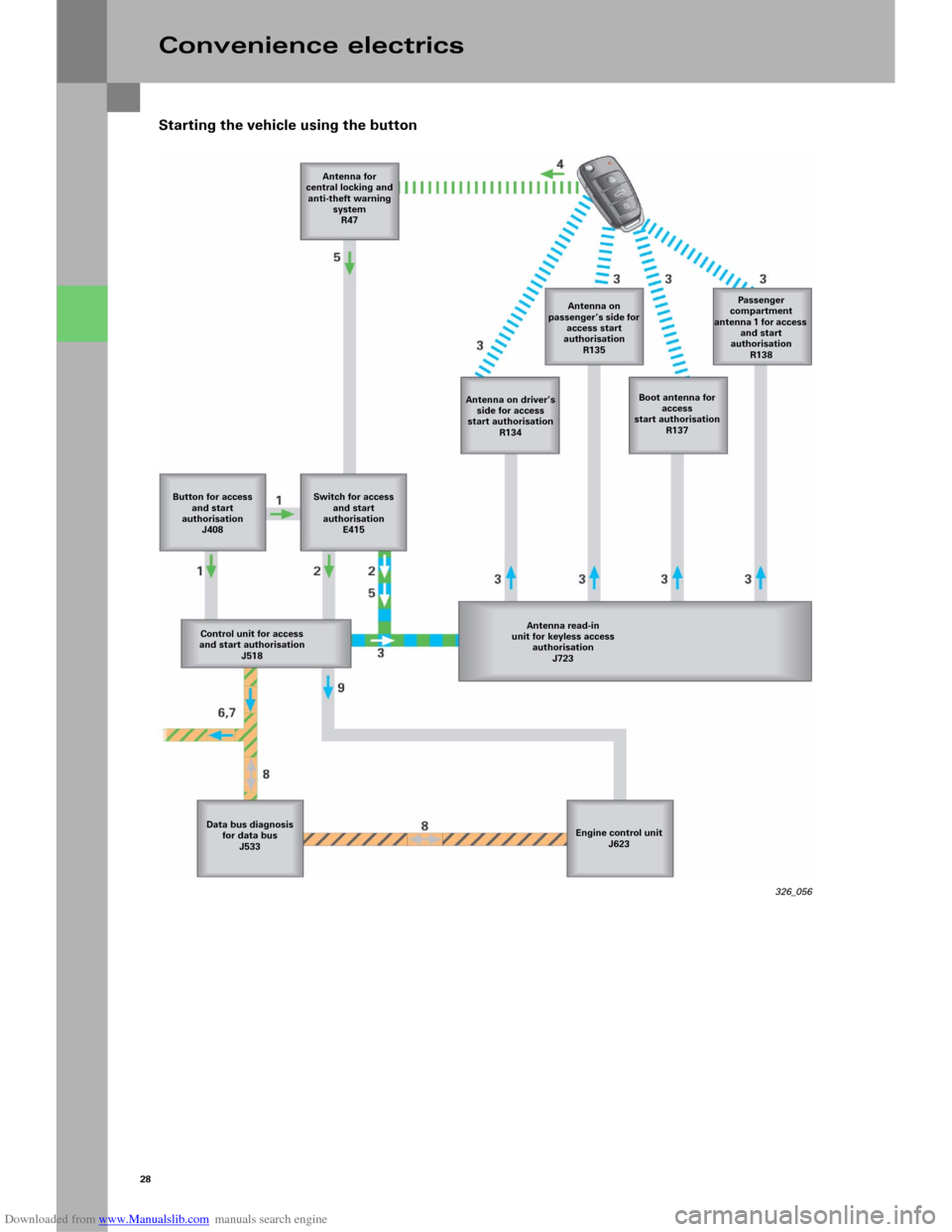
Downloaded from www.Manualslib.com manuals search engine 28
Starting the vehicle using the button
Convenience electrics
326_056 Antenna for
central locking and
anti-theft warning
system
R47
Antenna on driver’s
side for access
start authorisation
R134Antenna on
passenger’s side for
access start
authorisation
R135Passenger
compartment
antenna 1 for access
and start
authorisation
R138
Boot antenna for
access
start authorisation
R137
Switch for access
and start
authorisation
E415
Antenna read-in
unit for keyless access
authorisation
J723 Control unit for access
and start authorisation
J518
Data bus diagnosis
for data bus
J533Engine control unit
J623 Button for access
and start
authorisation
J408
Page 27 of 92
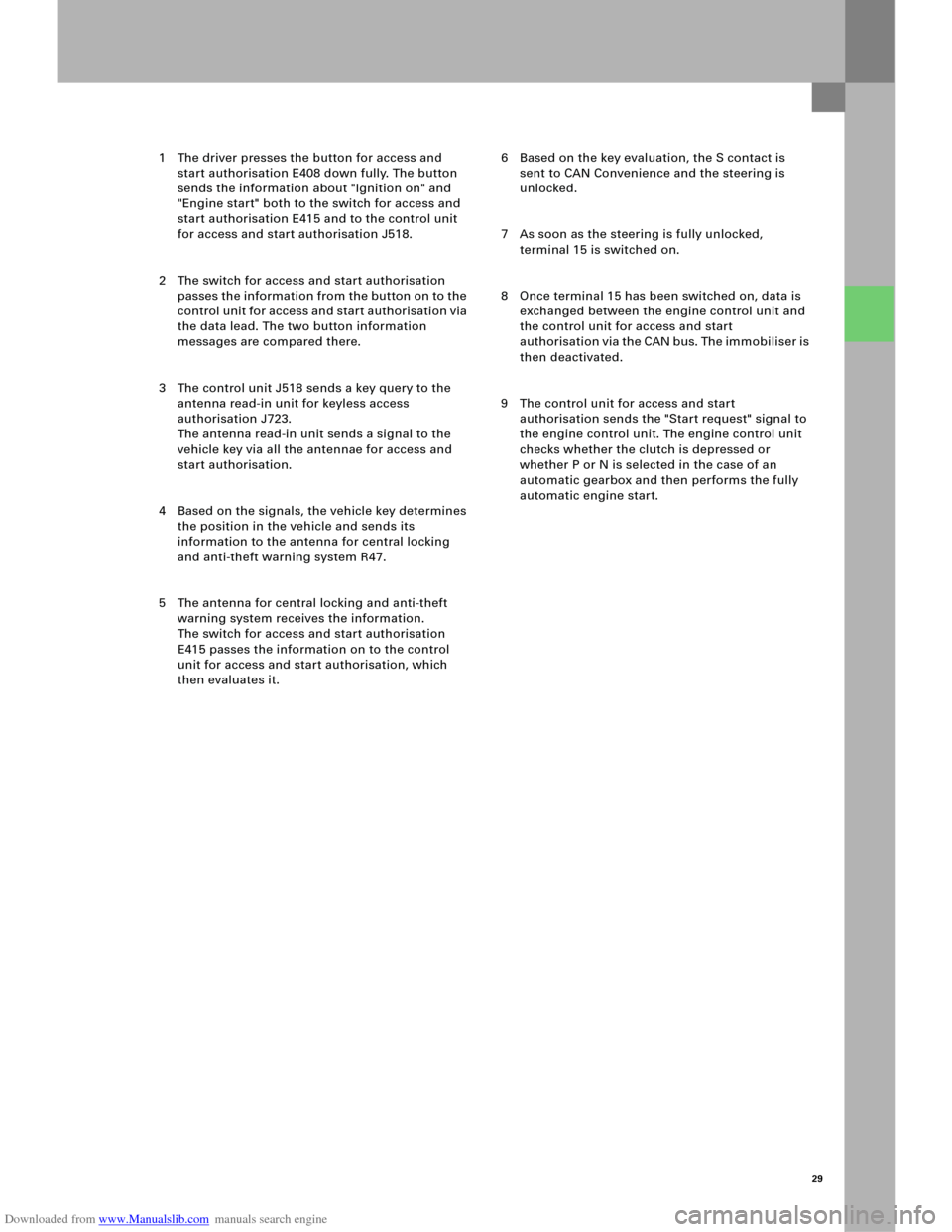
Downloaded from www.Manualslib.com manuals search engine 29
1 The driver presses the button for access and
start authorisation E408 down fully. The button
sends the information about "Ignition on" and
"Engine start" both to the switch for access and
start authorisation E415 and to the control unit
for access and start authorisation J518.
2 The switch for access and start authorisation
passes the information from the button on to the
control unit for access and start authorisation via
the data lead. The two button information
messages are compared there.
3 The control unit J518 sends a key query to the
antenna read-in unit for keyless access
authorisation J723.
The antenna read-in unit sends a signal to the
vehicle key via all the antennae for access and
start authorisation.
4 Based on the signals, the vehicle key determines
the position in the vehicle and sends its
information to the antenna for central locking
and anti-theft warning system R47.
5 The antenna for central locking and anti-theft
warning system receives the information.
The switch for access and start authorisation
E415 passes the information on to the control
unit for access and start authorisation, which
then evaluates it. 6 Based on the key evaluation, the S contact is
sent to CAN Convenience and the steering is
unlocked.
7 As soon as the steering is fully unlocked,
terminal 15 is switched on.
8 Once terminal 15 has been switched on, data is
exchanged between the engine control unit and
the control unit for access and start
authorisation via the CAN bus. The immobiliser is
then deactivated.
9 The control unit for access and start
authorisation sends the "Start request" signal to
the engine control unit. The engine control unit
checks whether the clutch is depressed or
whether P or N is selected in the case of an
automatic gearbox and then performs the fully
automatic engine start.
Page 28 of 92
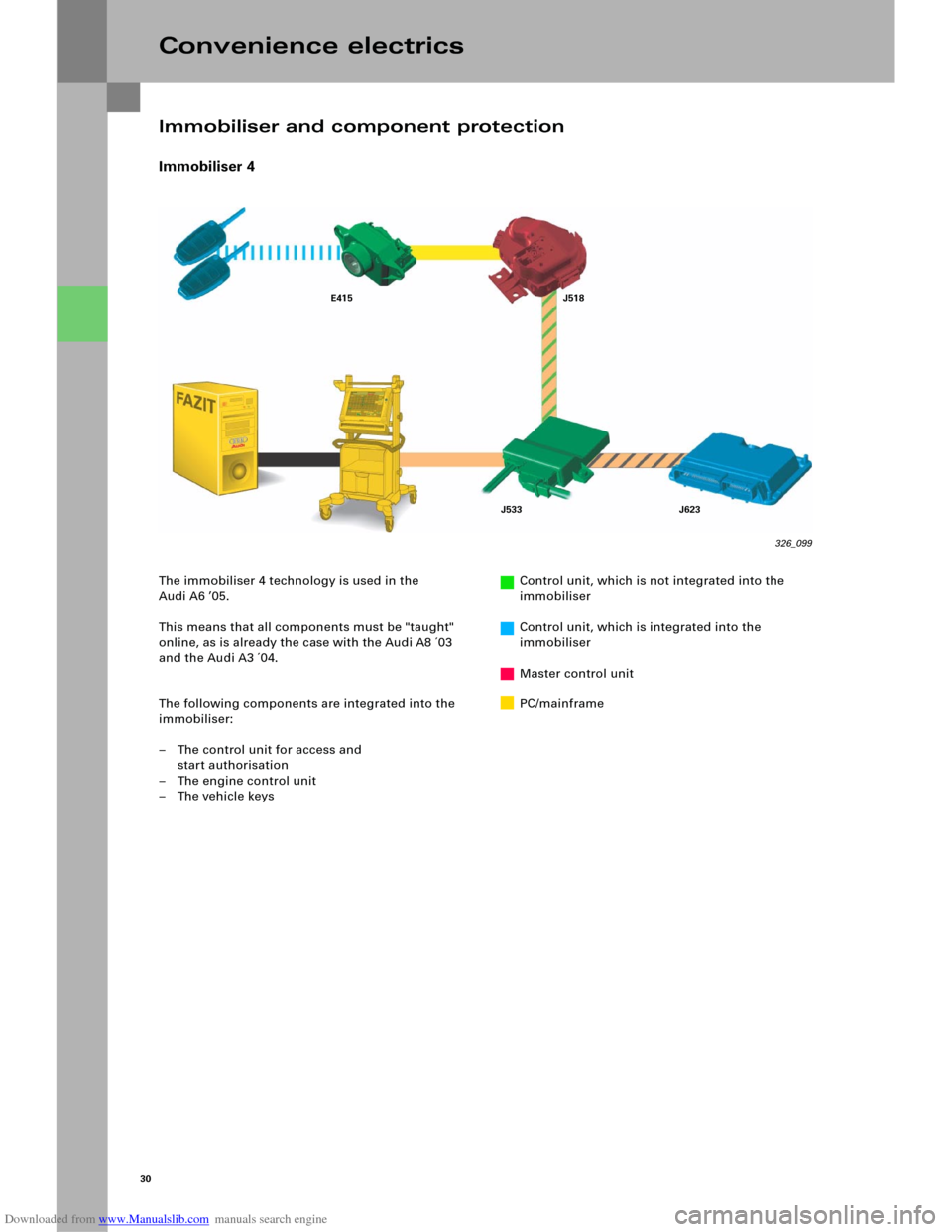
Downloaded from www.Manualslib.com manuals search engine 30
Immobiliser 4
Convenience electrics
The immobiliser 4 technology is used in the
Audi A6 ’05.
This means that all components must be "taught"
online, as is already the case with the Audi A8 ´03
and the Audi A3 ´04.
The following components are integrated into the
immobiliser:
– The control unit for access and
start authorisation
– The engine control unit
– The vehicle keysControl unit, which is not integrated into the
immobiliser
Control unit, which is integrated into the
immobiliser
Master control unit
PC/mainframe
326_099
Immobiliser and component protection
E415 J518
J533 J623
Page 29 of 92
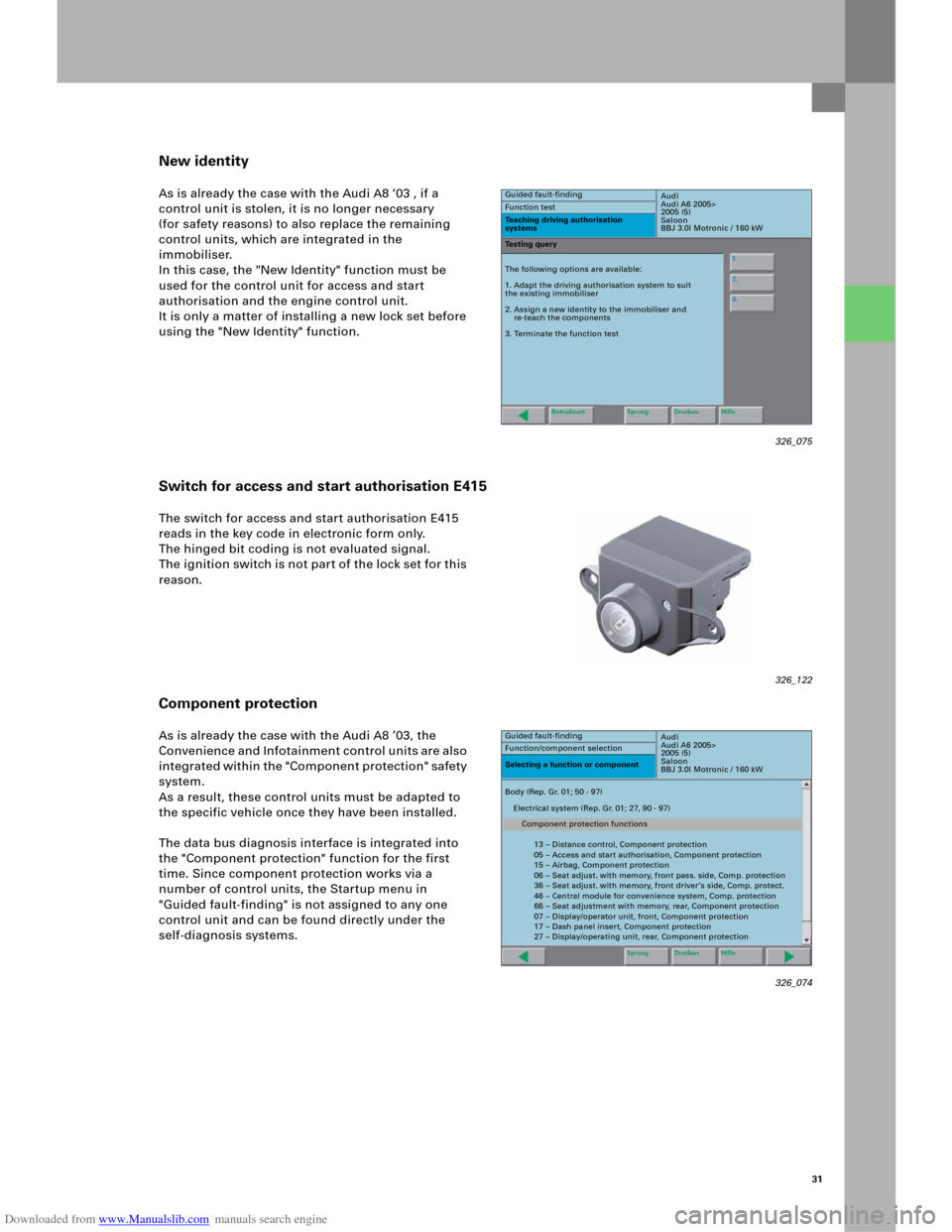
Downloaded from www.Manualslib.com manuals search engine 31
New identity
As is already the case with the Audi A8 ‘03 , if a
control unit is stolen, it is no longer necessary
(for safety reasons) to also replace the remaining
control units, which are integrated in the
immobiliser.
In this case, the "New Identity" function must be
used for the control unit for access and start
authorisation and the engine control unit.
It is only a matter of installing a new lock set before
using the "New Identity" function.
The switch for access and start authorisation E415
reads in the key code in electronic form only.
The hinged bit coding is not evaluated signal.
The ignition switch is not par t of the lock set for this
reason.
Component protection
As is already the case with the Audi A8 ’03, the
Convenience and Infotainment control units are also
integrated within the "Component protection" safety
system.
As a result, these control units must be adapted to
the specific vehicle once they have been installed.
The data bus diagnosis interface is integrated into
the "Component protection" function for the first
time. Since component protection works via a
number of control units, the Startup menu in
"Guided fault-finding" is not assigned to any one
control unit and can be found directly under the
self-diagnosis systems.
326_122 326_075
Audi
Audi A6 2005>
2005 (5)
Saloon
BBJ 3.0l Motronic / 160 kW Guided fault-finding
Function test
Teaching driving authorisation
systems
Te s t i n g q u e r y
The following options are available:
1. Adapt the driving authorisation system to suit
the existing immobiliser
2. Assign a new identity to the immobiliser and
re-teach the components
3. Terminate the function test
326_074
Audi
Audi A6 2005>
2005 (5)
Saloon
BBJ 3.0l Motronic / 160 kW Guided fault-finding
Function/component selection
Selecting a function or component
Body (Rep. Gr. 01; 50 - 97)
Electrical system (Rep. Gr. 01; 27, 90 - 97)
Component protection functions
13 – Distance control, Component protection
05 – Access and start authorisation, Component protection
15 – Airbag, Component protection
06 – Seat adjust. with memory, front pass. side, Comp. protection
36 – Seat adjust. with memory, front driver’s side, Comp. protect.
46 – Central module for convenience system, Comp. protection
66 – Seat adjustment with memory, rear, Component protection
07 – Display/operator unit, front, Component protection
17 – Dash panel insert, Component protection
27 – Display/operating unit, rear, Component protection
Switch for access and start authorisation E415
Page 30 of 92
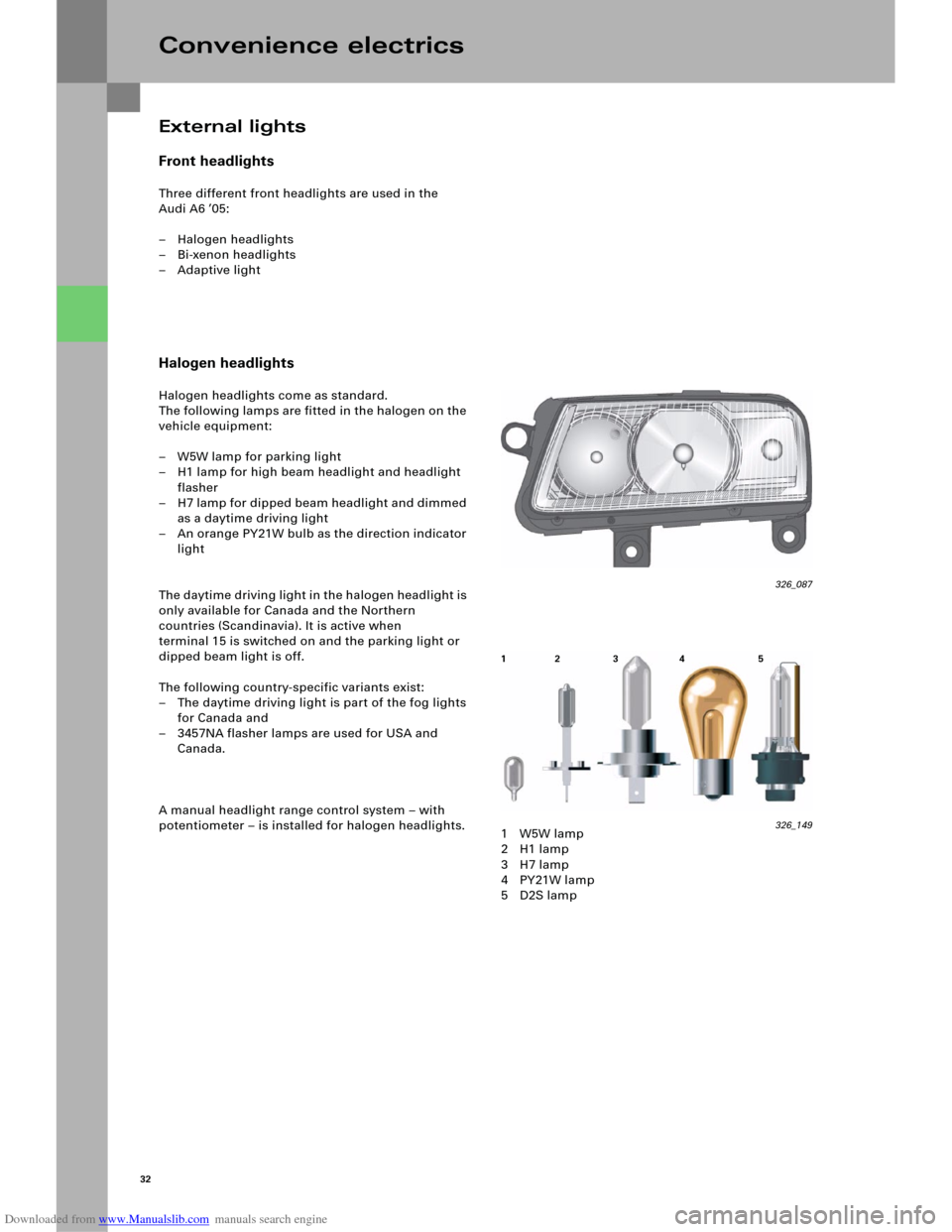
Downloaded from www.Manualslib.com manuals search engine 32
External lights
Front headlights
Three different front headlights are used in the
Audi A6 ’05:
– Halogen headlights
–Bi-xenon headlights
–Adaptive light
Halogen headlights
Halogen headlights come as standard.
The following lamps are fitted in the halogen on the
vehicle equipment:
– W5W lamp for parking light
– H1 lamp for high beam headlight and headlight
flasher
– H7 lamp for dipped beam headlight and dimmed
as a daytime driving light
– An orange PY21W bulb as the direction indicator
light
The daytime driving light in the halogen headlight is
only available for Canada and the Northern
countries (Scandinavia). It is active when
terminal 15 is switched on and the parking light or
dipped beam light is off.
The following country-specific variants exist:
– The daytime driving light is part of the fog lights
for Canada and
– 3457NA flasher lamps are used for USA and
Canada.
A manual headlight range control system – with
potentiometer – is installed for halogen headlights.
Convenience electrics
326_087
326_149
12 3 4 5
1W5W lamp
2H1 lamp
3H7 lamp
4 PY21W lamp
5D2S lamp
Page 31 of 92
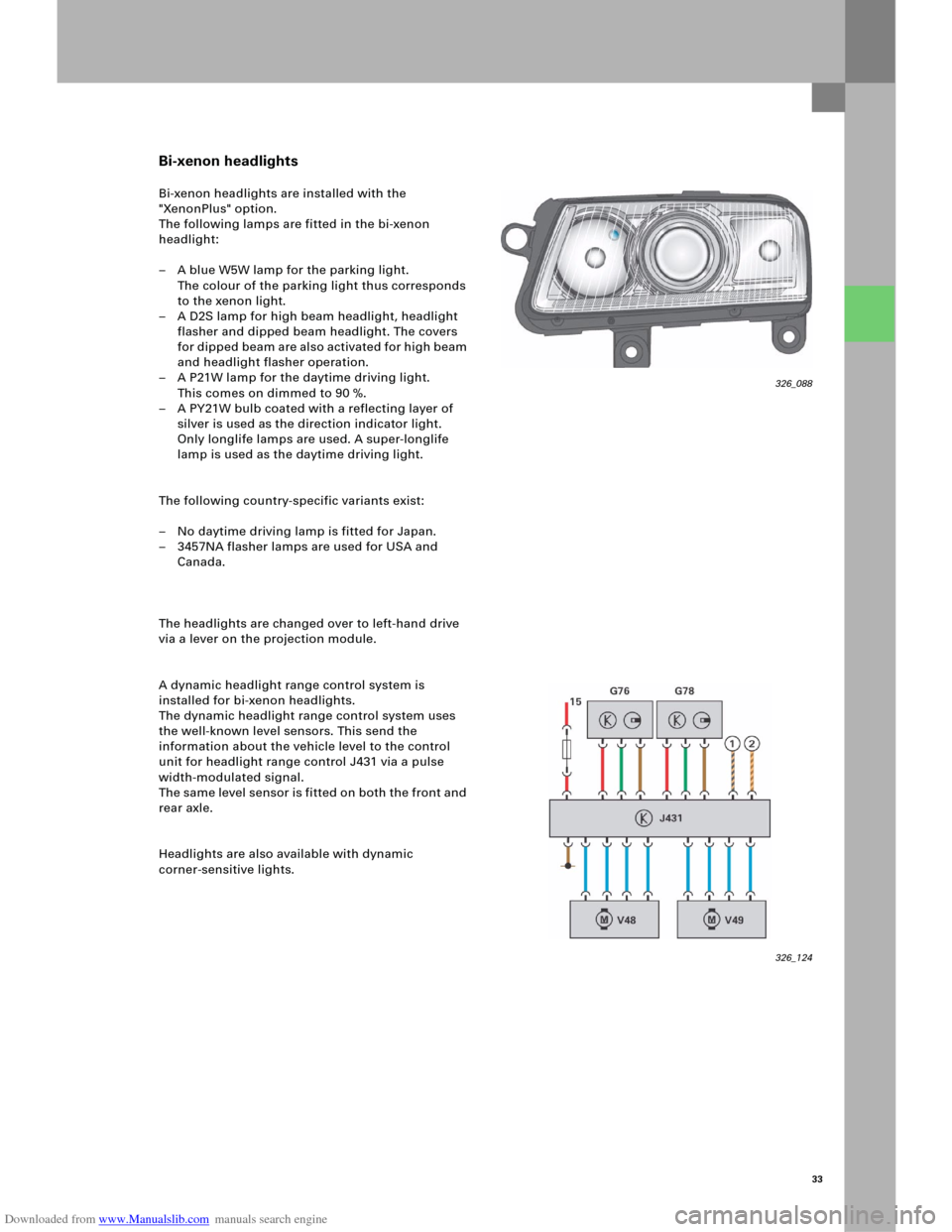
Downloaded from www.Manualslib.com manuals search engine 33
Bi-xenon headlights
Bi-xenon headlights are installed with the
"XenonPlus" option.
The following lamps are fitted in the bi-xenon
headlight:
– A blue W5W lamp for the parking light.
The colour of the parking light thus corresponds
to the xenon light.
– A D2S lamp for high beam headlight, headlight
flasher and dipped beam headlight. The covers
fo r d i p p ed b e am a re al s o a c t i v at e d fo r h i gh b ea m
and headlight flasher operation.
– A P21W lamp for the daytime driving light.
This comes on dimmed to 90 %.
– A PY21W bulb coated with a reflecting layer of
silver is used as the direction indicator light.
Only longlife lamps are used. A super-longlife
lamp is used as the daytime driving light.
The following country-specific variants exist:
– No daytime driving lamp is fitted for Japan.
– 3457NA flasher lamps are used for USA and
Canada.
The headlights are changed over to left-hand drive
via a lever on the projection module.
A dynamic headlight range control system is
installed for bi-xenon headlights.
The dynamic headlight range control system uses
the well-known level sensors. This send the
information about the vehicle level to the control
unit for headlight range control J431 via a pulse
width-modulated signal.
The same level sensor is fitted on both the front and
rear axle.
Headlights are also available with dynamic
corner-sensitive lights.
326_088
326_124
Page 32 of 92
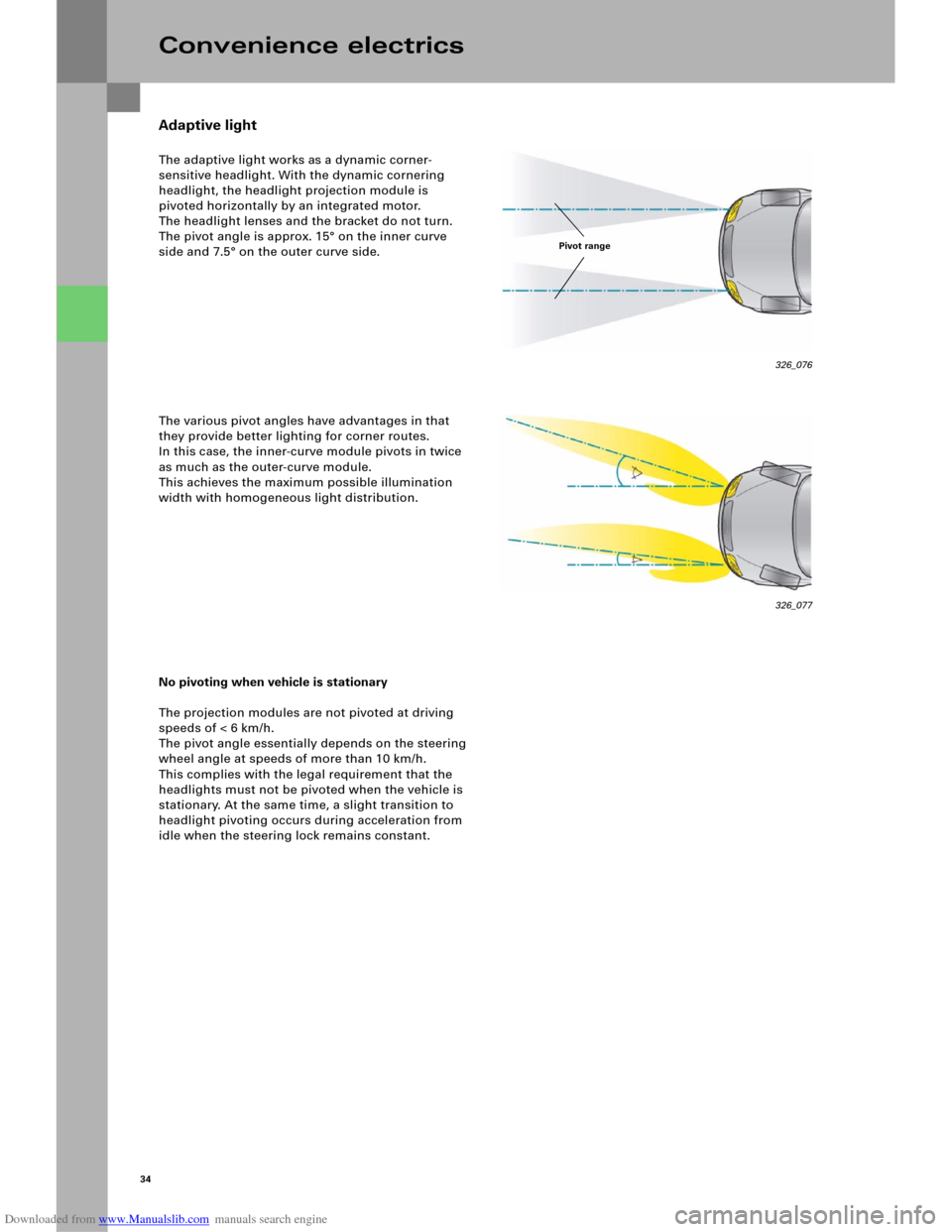
Downloaded from www.Manualslib.com manuals search engine 34
Adaptive light
The adaptive light works as a dynamic corner-
sensitive headlight. With the dynamic cornering
headlight, the headlight projection module is
pivoted horizontally by an integrated motor.
The headlight lenses and the bracket do not turn.
The pivot angle is approx. 15° on the inner curve
side and 7.5° on the outer curve side.
The various pivot angles have advantages in that
they provide better lighting for corner routes.
In this case, the inner-curve module pivots in twice
as much as the outer-curve module.
This achieves the maximum possible illumination
width with homogeneous light distribution.
No pivoting when vehicle is stationary
The projection modules are not pivoted at driving
speeds of < 6 km/h.
The pivot angle essentially depends on the steering
wheel angle at speeds of more than 10 km/h.
This complies with the legal requirement that the
headlights must not be pivoted when the vehicle is
stationary. At the same time, a slight transition to
headlight pivoting occurs during acceleration from
idle when the steering lock remains constant.
Convenience electrics
326_077
Pivot range
326_076